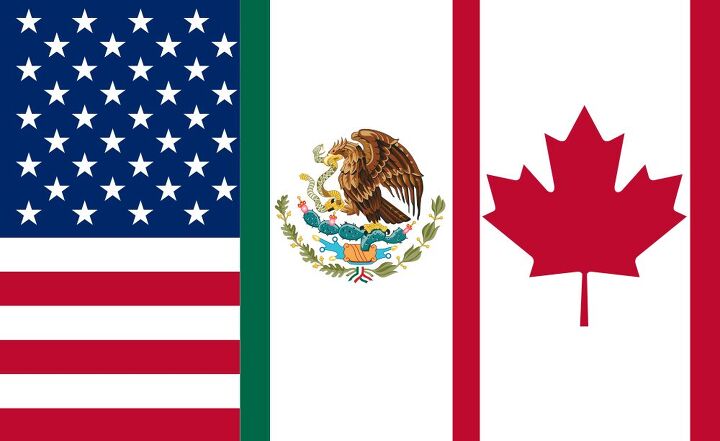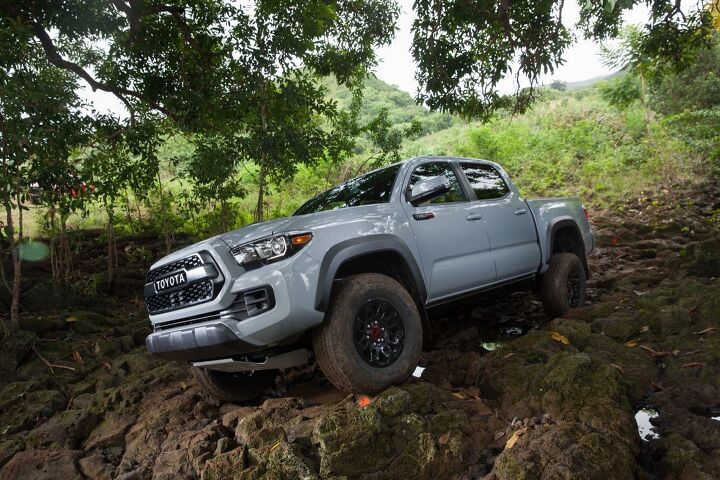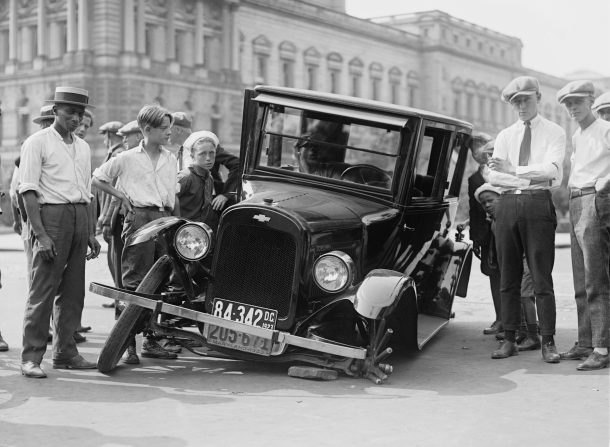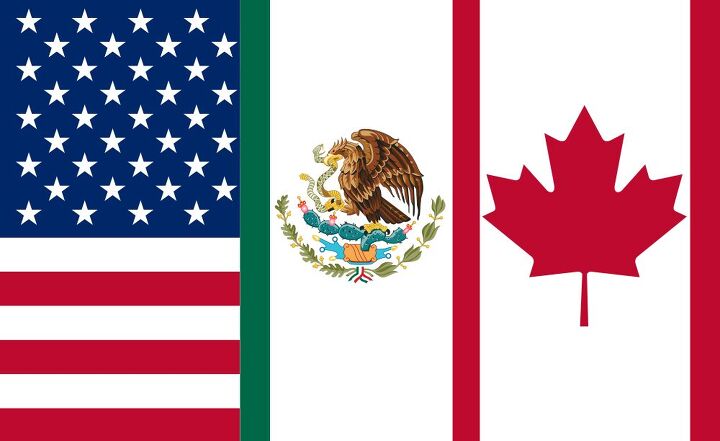#DonaldTrump
NAFTA Talks Finally Progressing Slightly Better Than a Dumpster Fire
After what could be called some of the least productive negotiations in North American history, some progress is finally being made on the North American Free Trade Agreement. We know, with all of the negative rhetoric being slung from all sides, it sounds impossible. However, all three trading partners are beginning to bend on some of the issues that have proven the trickiest to navigate.
Among them is the faintest glimmer of hope that the automotive content requirements pushed by the United States might be adopted by the other nations, albeit in a modified form.
Still, progress is progress, and it only took about six months to get to a point where some meaningful headway could finally be made. Absolutely incredible. Let’s give these officials a huge round of applause for really getting in there, taking care of business, and not wasting a bunch of time.
The GAC Effect: Imported Chinese Automobiles Face Fierce Criticism From U.S. Politicians
At this very moment, Chinese-based automaker GAC has a massive booth in the very center of the North American International Auto Show in Detroit. The company has expressed its intent to start importing its vehicles into the United States in 2019. However, 536 miles away (by car), Washington is bemoaning Chinese trade practices — a topic which might be extremely relevant for Guangzhou Automobile Group in the coming years.
On Wednesday, Democratic U.S. Senator Chuck Schumer and President Donald Trump separately criticized China’s trade policy. For automobiles, this translates into Chinese-built cars incurring a maximum 2.5 percent import tariff upon entering the United States, while U.S.-built cars sent East are hit with an average 25 percent tax.
Trump's Updated Fuel Economy Targets Are Coming This March
After what feels like an eternity, the Trump Administration finally feels confident in releasing its alternative to efficiency rules created under former President Barack Obama. The National Highway Traffic Safety Administration will provide the details on the new fuel economy standards for cars and light trucks sometime before the end of March.
This will be followed by partisan arguments as to why it’s the best and worst idea in the world.
Union Boss Reassures Everyone That NAFTA Is Toast
With everyone weighing in on the ultimate fate of the North American Free Trade Agreement, it almost seems as if we’re cataloging their bets to see just how right or wrong they’ll be in the negotiatory aftermath. Considering there has been such a limited amount of progress on the trade talks, there honestly isn’t much else to do.
Suggesting that NAFTA is “is going to blow up in 2018,” Jerry Dias, president of the Canadian union Unifor, has planted his flag on the side of a total breakdown of the agreement. Unifor represents 23,500 Detroit Three auto workers living north of the border, plus some 16,000 working in the supply chain.
As a union leader, Dias is prone to hyperbolic statements. However, his insight into the situation runs a little deeper than most.
NAFTA Update: Nobody Has Any Idea What's Going On
In case you haven’t kept up with the coverage on the renegotiation of the North American Free Trade Agreement, things haven’t gone well. Despite wrapping the latest round of talks in Washington on Friday, negotiators have made no clear progress on updating the trade deal. Considering a new deal is supposed to be finalized by the end of March, it’s beginning to look as if the NAFTA revamp might be doomed.
The biggest issue crippling the talks continues to be regional-content requirements for cars to qualify for NAFTA benefits. Both Mexico and Canada have described the U.S. content proposals as “unworkable.”
Pence Meets With Automakers Annoyed by NAFTA Changes
The automotive industry is wary of any changes that might be made in regard to the North American Free Trade Agreement. Fortunately for them, little progress has been made during the last few months of negotiations. But that doesn’t create an assurance that changes aren’t still en route. So, manufacturers and suppliers have banded together via various trade groups to voice their opinion on how to best handle NAFTA.
Meanwhile, the Trump administration has attempted to make itself appear friendly to the automotive business. Continuing these efforts, Vice President Mike Pence has met with General Motors CEO Mary Barra, Fiat Chrysler’s Sergio Marchionne, Ford North America President Joe Hinrichs, and a handful of other top-tier auto executives.
House Members Aren't Digging Trump Administration's Auto Trade Proposals
A bipartisan group of over 70 members of the U.S. House of Representatives has asked the Trump administration to reconsider its North American Free Trade Agreement proposal on auto parts rules of origin. Seen as a sunset clause by Canada and Mexico that tweaks international agreements to lower the United States’ trade deficit, the rule has also received some serious blowback from domestic automakers. They’ve even used trade groups to craft awareness campaigns and reach out to congress, a decision that appears to be working.
Currently, NAFTA mandates at least 62.5 percent of the materials used in a car or light truck be sourced from North America in order to avoid tariffs. The Trump administration’s proposal would up that requirement to 85 percent, with 50 percent of the total being from the United States.
Toyota's Truck Production Plans Largely Dependent on NAFTA Existing
Despite President Trump giving Toyota significant praise for its continued investment in the United States last week, the success of the automaker’s production plans hinge on the continuation of NAFTA — something the Commander in Chief has been vehemently opposed to since his well-before his inauguration.
Toyota and Mazda’s $1.6 billion factory is anticipated to yield 150,000 Corollas annually and free-up assembly facilities in Mexico that would build the Tacoma pickup. However, if the North American Free Trade Agreement is dissolved, anything produced south-of-the-boarder could be subjected to the chicken tax. Were that to happen, Toyota would be placed into quite a predicament and faced with high import taxes on any trucks it had hoped to ship to the U.S.
Real Fake News: Donald Trump and Where Japanese Manufacturers Choose to Build Their Cars
On Monday, President Donald Trump requested that Japanese automakers consider assembling their vehicles in the United States. “Try building your cars in the United States instead of shipping them over. That’s not too much to ask,” Trump told Japanese auto executives during this week’s visit. “Is it rude to ask?”
While the internet response was to immediately scoff at how little Trump knew about the industry (Japanese companies have been building automobiles in North America for decades), the reality was far more nuanced.
Taken in the broader context, Trump actually said, “Several Japanese automobile industry firms have been really doing a job. And we love it when you build cars — if you’re a Japanese firm, we love it — try building your cars in the United States instead of shipping them over. Is that possible to ask? That’s not rude. Is that rude? I don’t think so.”
QOTD: Do You NAFTA Go Back?
An “army” of lobbyists has come to Capitol Hill. American automakers are “speaking with a unified voice” in pursuit of a single goal. The business media and papers of record are pushing a message that hasn’t been this identical since this time last year, when they were competing with each other to see who could most strongly support a certain inevitable presidency.
What’s got everybody so upset?
Automakers Unify to Urge Trump to Keep NAFTA
Domestic automakers and suppliers have already expressed concerns that leaving the North American Free Trade Agreement could be detrimental to the industry. Numerous automotive trade groups have claimed that losing NAFTA would result in less efficient and more costly ways of doing business.
Hoping to steer Donald Trump away from the idea of abandoning the three-country accord, manufacturers, parts suppliers, and dealers have come together to form the “Driving American Jobs” coalition. The group’s primary goal is to prove that NAFTA has been beneficial to the participating countries, especially the United States. It also makes the claim that withdrawing from NAFTA would re-establish trade barriers, hurt the U.S. economy and cost jobs.
“We need you to tell your elected officials that you don’t change the game in the middle of a comeback. We’re winning with NAFTA,” urges the group’s website.
Ending NAFTA Could Cost U.S. 50,000 Auto Jobs: Study
Automotive trade groups have issued warnings about the scrapping of the North American Free Trade Agreement all year. In January, the Center for Automotive Research claimed killing NAFTA could result in the elimination of at least 31,000 auto jobs within the United States. This week, a new study sponsored by the Motor Equipment Manufacturers Association upped that estimation to around 50,000.
With early negotiations not going particularly well at the moment, the new tally serves as a potential warning. If NAFTA is abandoned, North American countries would all likely revert to rules dictated by the World Trade Organization, resulting in higher tariffs from all sides.
While 50,000 fewer jobs is the upper echelon of what could be expected, a few things have to go wrong for it to reach that point. First, Mexico and Canada would have to revert to pre-NAFTA tariff levels — which were comparably higher than the United States. If so, manufacturers would almost assuredly begin sourcing more parts from the same countries where the vehicles are assembled, and gradually move production to lower-cost regions like China.
The NHTSA: Broken Down, Short on Staff, Slow on Change
The United States is still waiting on a glut of senior appointments within agencies that affect the automotive industry. While the Environmental Protection Agency eventually got Scott Pruitt, many high-ranking positions remain vacant at the EPA and other U.S. regulatory groups. The National Highway Traffic Safety Administration is still missing an administrator, chief counselor, director for government affairs, chief financial officer, and one enforcement chief.
With so many holes in its staff, former NHTSA officials and consumer advocacy groups are worried the agency has been rendered ineffective — essentially stalled on important decisions and issues that need the right kind of signature. Eight months is a long time to wait for an appointment and the NHTSA was only just given a deputy administrator, after former executive director Jack Danielson’s promotion.
U.S. Is Intentionally Sabotaging NAFTA Trade Talks, Officials Claim
President Donald Trump entered into office threatening to abandon the North American Free Trade Agreement if the United States was not given a better deal immediately. But, after negotiations began, it looked as if his ultimatum would be unnecessary.
Now, U.S. officials involved in NAFTA negotiations are being accused of making proposals on issues Mexico and Canada have said they would never agree to. Are these bold negotiation tactics being used to place the U.S. in a better position for future issues, or are trade arbitrators intentionally trying to sabotage talks so Trump can make good on his promise to leave the agreement?
Trump Flips Script on Who's Paying to Fix Our Crumbling Infrastructure
Last week, I defended the president’s honor and lamented that I probably wouldn’t have a follow-up opportunity for some time. As it turns out, that claim is in no danger of becoming a falsehood. On Tuesday, President Trump told lawmakers he was ditching a key aspect of his planned $1 trillion infrastructure package — namely, who is going to pay for it.
Spoiler alert: its going to be taxpayers.
The White House previously envisioned a strategy where private investors would be lured into rebuilding roadways, bridges, and rail networks with promises of federal backing and a less-daunting approvals process. But now it’s saying partnerships between the private sector and federal government might not work.






























Recent Comments